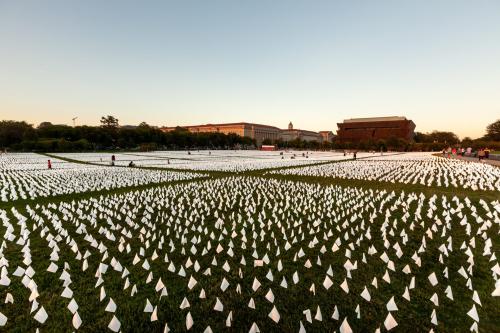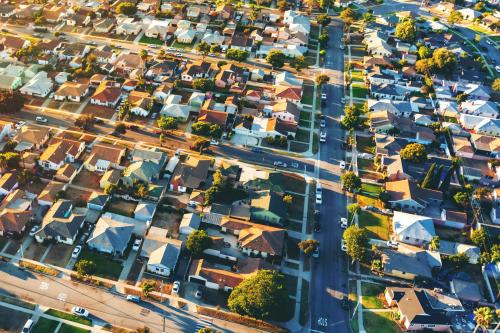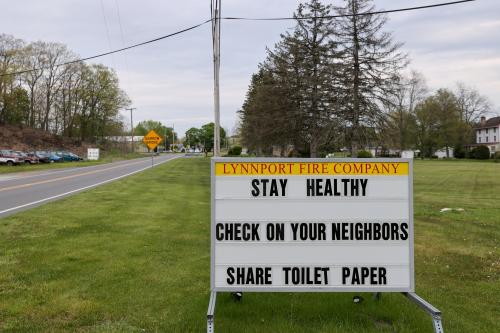Earlier this year, the National Center for Health Statistics (NCHS) published data showing a 1.5-year decline in national life expectancy in 2020, largely due to the COVID-19 pandemic, which took the lives of approximately 375,000 Americans that year. The NCHS reported that white Americans’ life expectancy declined by 1.2 years; for Black Americans, that number was 2.9 years.
This racial disparity in life expectancy is a lagging indicator of disparities that have existed throughout the pandemic. According to the most recent Centers for Disease Control and Prevention data, Black people are 1.1 times more likely than white people to contract COVID-19; 2.8 times more likely to be hospitalized with the virus; and two times more likely to die from it. These disparities help to explain why, when adjusting for age, Black people account for 22.1% of the nation’s COVID-19 deaths despite only comprising 12.8% of the population.
The causes of these racial disparities are hotly debated, and many fixate on the role of individual behavior—for example, a recent Brookings analysis cited vaccine hesitancy as a key driver of disparate death rates. But while personal behavior matters, social determinants of health at the local level play an outsized role. Because de jure and de facto segregation concentrated Black Americans in specific locales, racial injustices have occurred through place-based discrimination: disproportionate exposure to pollution and hazardous waste, harmful zoning practices, and post-disaster displacement, to name a few. Rather than blaming Black people for their suffering, the conditions of place must be examined to understand the mechanics of racial discrimination that contribute to that suffering.
Two findings highlight hyperlocal variation in life expectancy prior to the pandemic
Finding #1: Neighborhood life expectancy correlates with neighborhood demographics
We compared life expectancy across neighborhoods where the population of Black residents ranged from less than 1% to over 50%. The graph below shows that at the national level, neighborhood life expectancy decreases as the Black population percentage increases. Neighborhoods with a 10% Black population or higher have an overall life expectancy lower than the national average of 78.7 years. Black-majority neighborhoods have a lower life expectancy by approximately 4.1 years, and neighborhoods with a Black population of less than 1% have a higher life expectancy by around one year compared to the national average.

Throughout the pandemic, most geographic analyses of differing health outcomes focused on comparing different states, metro areas, and counties. The comparisons are important, but these geographic areas are not homogenous units. There can often be as many stark differences found within a metro area as are found across metro areas—a fact underscored in our second finding below.
Finding #2: Neighborhood life expectancy disparities exist relative to the surrounding metro area
We found that Black-majority neighborhoods had relatively lower life expectancy when compared to the aggregate metro area in which those neighborhoods were located. As shown in the map below, the difference in life expectancy between a Black-majority neighborhood and its surrounding metro area can be as high as nine years.

Both findings illuminate the fact that racial gaps in life expectancy manifest as place-based problems. But one alternative way of interpreting these findings is that Black people might carry life expectancy decline with them into the neighborhoods they live in, such that the crucial variable is the people, not the place. Supporters of this view could point to the fact that there are persistent (though narrowing) nationally aggregated racial gaps in life expectancy that extend backward for many decades.
While there is some credence to this view, we don’t think it tells the full story. For example, recent research comparing states found that “geographic inequality in mortality for midlife Americans increased by about 70 percent between 1992 and 2016”—underscoring the significance of place as a driver of outcomes. Additional research using experimental and quasi-experimental methods further highlights the role of neighborhoods as a driver of health and well-being outcomes.
In our recent report on social determinants of health, we identified two place-specific factors that help explain disparities in health outcomes: housing insecurity (including rates of foreclosure and eviction) and exposure to environmental hazards (particularly toxic air), which are both more common in Black neighborhoods. Social determinants related to labor markets—including labor force participation, employment conditions, and access to employer-sponsored health care—are additional factors that are often highly correlated with neighborhood characteristics and location.
Thus, a better interpretation for neighborhood-level differences in life expectancy is that whiteness bestows a noticeable social and economic premium on localities, including neighborhoods—where whiteness is understood not as an intrinsic individual characteristic but rather as a social construct that enables various systemic and structural advantages for these neighborhoods compared to Black neighborhoods.
As an initial example of these structural advantages and disadvantages, previous Brookings research found persistent devaluation of homes in Black-majority neighborhoods, even when controlling for objective metrics such as home size and neighborhood amenities. Contrary to what other researchers have claimed, additional research by our team clearly demonstrates that these disparities are not driven by socioeconomic factors but are instead the result of racial bias, as these neighborhoods are systematically viewed as less safe and of lesser quality based on racial makeup.
As a result of this bias and devaluation, once-successful Black neighborhoods often undergo cycles of disinvestment and disrepair, priming them for gentrification. In addition to undermining Black wealth for individuals and the community, this devaluation also erodes tax revenue via property tax, which compromises the ability of localities to adequately fund public goods and services. White neighborhoods benefit from the opposite dynamic, wherein homes are overvalued relative to the tax-assessed value. Our team has also established evidence that these same undervaluation issues are found in regards to Black businesses.
This interpretation of white privilege as a spatial phenomenon rather than an individual characteristic helps to explain why life expectancy in white neighborhoods is higher even as there have been persistent declines in life expectancy for white people in recent years. For example, from 2013 to 2014, life expectancy decreased for white people but increased for Black people—yet this does not show up at the neighborhood-level analysis. And from 2014 to 2015, there was a national aggregate life expectancy decline of 0.2%—but when disaggregated by race, Black people had a lower decline (0.1%) than white people (0.2%).
Thus, we believe that neighborhood-level differences in life expectancy connect to residential segregation, which is often driven by income and wealth stratification reflecting a legacy of systemic racism.
Residential segregation is the highest it has been in decades
Pundits and politicians often speak about racial progress as though it is an inevitable march in the right direction. But at least on some metrics, we have lost ground compared to previous decades. This is especially the case when it comes to racial integration in major metro areas.
According to research from the University of California, Berkeley’s Othering & Belonging Institute, “81 percent of metropolitan regions with a population above 200,000 were more segregated in 2019 than they were in 1990.” The report found that these segregation patterns both reflect and extend the systemic racism encoded in 20th century law: “83 percent of neighborhoods that were given poor ratings (or ‘redlined’) in the 1930s by a federal mortgage policy were as of 2010 highly segregated communities of color.” These patterns directly shape the financial characteristics of these neighborhoods, with the report finding that “neighborhood poverty rates are highest in segregated communities of color (21 percent), which is three times higher than in segregated white neighborhoods (7 percent).”
In her new book, Georgetown Law professor Sheryll Cashin describes these segregation patterns as “a system of residential caste that harms those who cannot buy their way into bastions of affluence.” In the context of our research, we add that this racialized residential caste system affects which neighborhoods can buy their way into better communal health outcomes. Since neighborhoods are often the starting point of the social determinants of health we explored in our report, accessing “better” neighborhoods—neighborhoods with cleaner air quality, more green space, higher public expenditure on public goods—can add years of life.
To be clear, we believe there are many social and political benefits to having more racially integrated neighborhoods. And we strongly object to the many ways that white enclaves of wealth use restrictive zoning, real estate steering, and other such practices to make it harder for Black people to move into the neighborhood. But Black people should not have to attach themselves to places that benefit from white privilege in order to flourish. Living in a Black-majority neighborhood should not be a death sentence imposed via lack of public investment and the kinds of “boundary maintenance, opportunity hoarding and stereotype-driven surveillance” patterns that Cashin describes.
As we slowly recover from the intersecting health and economic crises caused by the COVID-19 pandemic, it is essential to advocate for the kind of public investment that will create greater equity and allow for everyone to live healthily—regardless of their race or place.








Commentary
Why is life expectancy so low in Black neighborhoods?
December 20, 2021